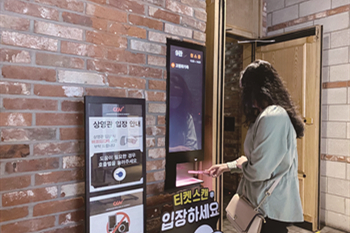
In the wake of the coronavirus pandemic, film and theater industries are losing customers due to social distancing. As a countermeasure to overcome this problem, untact culture, which reduces the chance of physical interaction, is gaining attention from these industries.
The number of people heading to the theatres decreased as many are avoiding crowded places to reduce contact with others. According to the MBC broadcasting station, the Korean film industry’s sales this year decreased by 70 percent compared to last year due to the outbreak.
In order to solve this issue, the movie industry came up with the idea of ‘untact cinema’. It is a new type of cinema which utilizes facilities based on a variety of high-tech options and ‘untact’ services to reduce interaction between customers and workers. The new cinema tactic targets the generation-z and millennials specifically who are familiar with high-tech integration.
CGV Yeouido is in the lead to implementing the concept of ‘untact cinema’. There are pick-up boxes where people can order by utilizing the store kiosk, which removes the need to stand in lines. Popcorn factory self-service bars allow customers to grab their snacks right out of the self-serve bar, and smartcheck robots answer inquiries from the customers instead of workers.
Chang Yeong-yeop, the editor in chief of the Korean film magazine CINE21, shared her opinions on ‘untact cinema’.
“By introducing ‘untact cinema,’ movie industries are minimizing the economic loss due to the corona spread,” she said. “Also, they attempt to reinforce a positive image of movie theatres that they are safe places.”
She also expressed a concern of the service.
”Middle-aged people would feel uncomfortable with the service as they are unfamiliar with such high technology services.”
“It is true that ‘untact cinema’ is currently introduced to some movie theatres as a solution to the COVID-19 crisis,” Lee Hyo-lim, the president of the school movie club NOUE (Scene Shot Cut Take) commented. “However, I believe the contactless method would be commonly utilized even after the COVID-19 pandemic ends due to the advance of Artificial Intelligence.”
The performing arts industry is also going through a tough time amid the spread of the virus. All public theaters were closed during the social distancing period from March 22 to May 5. Most art performance halls were advised to stop operation for a certain period by the government.According to a research conducted by the Federation of Artistic & Cultural Organization of Korea (FACO), about 2,500 art performances were cancelled from January to April, and the resulting financial damage is estimated to be around 52.4 billion won.
Aside from the loss due to the closure of the theaters, art centers needed to manage all the refunds of the tickets they sold before the pandemic. Private art halls had to deal with the economic loss on their own, which led to some of them shutting down.
Some theaters have applied the untact concept by uploading performance videos online or providing online streaming services for live stream sessions. For example, both the Seoul Art Center (SAC) and the Seoul Philharmonic Orchestra have broadcasted live streams of performances and concerts on their YouTube channel.
Cho In-kyo, a sophomore at Sungkyunkwan University, provided an overall review of the live concert streaming service including the musical Marie Curie.
“I could enjoy the performance from various perspectives as cameras filmed the performance at different angles,” Cho said. “It is great that everyone could watch performances in equal quality, whereas the quality always differed with in-house performances depending on the seats and the ticket price.”

